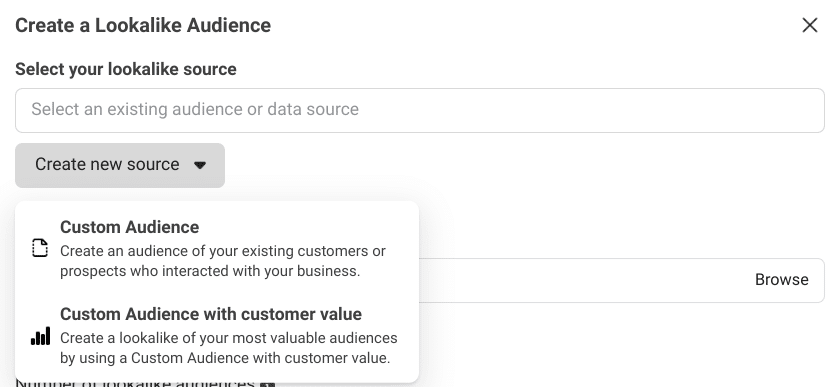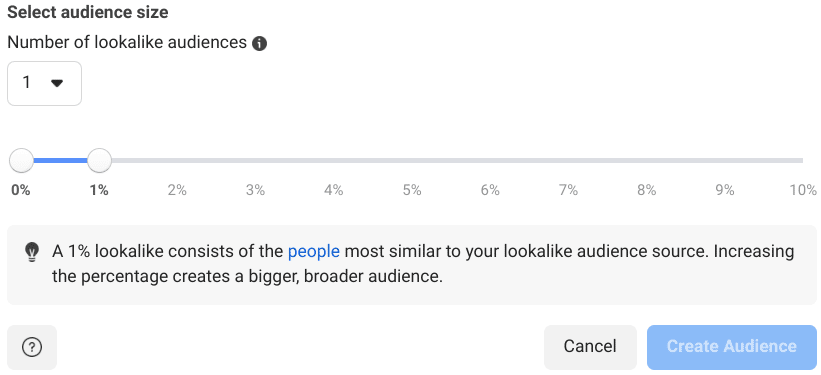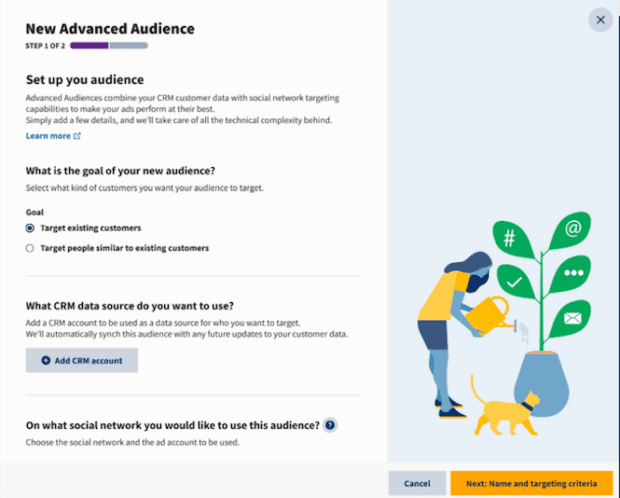How to Use Facebook Lookalike Audiences [2023 Guide]
Facebook Lookalike Audiences is a sophisticated matchmaker between your brand and new fans — and a powerful advertising tool. You tell Facebook the characteristics of your favorite customers, and Facebook recommends a new target audience filled with prospects that meet your criteria.
Ready to find the audience of your dreams? Read on to learn how to create a Lookalike Audience for your Facebook ads, plus tips that will help you find the best match.
Bonus: Get the Facebook advertising cheat sheet for 2022. The free resource includes key audience insights, recommended ad types, and tips for success.
What is a lookalike audience on Facebook?
A Facebook Lookalike Audience is a custom advertising audience that can be used to reach people similar to your current customers.
How are Facebook Lookalike Audiences created?
Facebook’s advertising system takes an existing audience, identifies its key characteristics (like behavior and interests), and then finds similar audiences sharing those traits.
You can pair Lookalike Audiences with other ad targeting parameters, such as age and gender or interests and behaviors.
Benefits of Facebook Lookalike Audiences
People in a Lookalike Audience are more likely to engage with your content than the general public, which makes this type of ad targeting particularly valuable. Here are other reasons to choose Lookalike Audiences over other types of ad targeting on Facebook:
- Easier to find high-quality leads. You can reach new people outside of your customer list with Lookalike Audiences. But not just any person on Facebook – you are specifically targeting people who share similar characteristics to your top customers. This means they are more likely to be interested in your ad.
- More value on ad spend. Experimentation is necessary for social media ads, but no one wants to spend more money to find their top-performing ad. With Lookalike Audiences, you can test multiple audiences at once without needing to create several campaigns.
- Saves you time. Lookalike Audiences make it easy to find audiences interested in your ad without additional work on your end. If you already have an existing audience, then you can use it to find Lookalike Audiences.
How to use Facebook Lookalike Audiences
Before you even begin creating a Facebook Lookalike Audience, you’ll need to create a Custom Audience first. Then Facebook will use the Custom Audience to create your personalized Lookalike Audience.
The steps to create a Custom Audience will depend on the source. (But don’t worry, we have a full guide on how to create a Custom Audience).
These are the basic steps to create a Custom Audience:
Step 1: Prepare your customer list in advance by creating a CSV or TXT file. You may also want to install Meta Pixel on your website to track visitors.
Step 2: Go to Audiences within your Ad Manager.
Step 3: Choose a Custom Audience source. Your options include website, app activity, catalog, customer list, and offline activity.
Step 4: Follow the instructions to create your Custom Audience based on the source you chose in Step 3.
Once you’ve created your Custom Audience, you can use it to set up a Lookalike Audience. Here are the steps to create a Facebook Lookalike Audience:
Step 1: Select Create a Lookalike Audience within the Ad Manager.
Step 2: Choose your source. Remember, this will be a custom audience you’ve created from customer information, Pixel or app data, or fans of your page. You can also create a new source at this point.
Note: Your source audiences need to contain at least 100 people from the same country. Facebook also generally recommends a source audience that has between 1,000-5,000 people, but high-quality sources take priority.
Step 3: Select the countries or regions you would like to find a similar group of people. The areas you choose will determine where people in your Lookalike Audience are based, essentially adding a geo-filter onto your Lookalike Audience.
Note: You don’t have to have anyone from the country you want to target in your source.
Step 4: Choose your desired audience size with the slide. Size is expressed on a scale of 1-10. Smaller numbers have a high similarity to your source audience. Meanwhile, larger numbers have higher reach but less similar characteristics. Facebook will provide you with an estimated reach for the size you choose.
You can also create multiple Lookalike Audiences with different levels of similarity to your source.
Step 5: Click Create Audience. And you’re all set! It can take between six and 24 hours for your Lookalike Audience to be finished.
Bonus: Get the Facebook advertising cheat sheet for 2022. The free resource includes key audience insights, recommended ad types, and tips for success.
Get the free cheat sheet now!How to set up a Facebook Lookalike Audience in Hootsuite
Facebook’s Ad Manager can be overwhelming, especially for beginners. To keep things simple, manage your Facebook ads alongside all of your organic content in Hootsuite.
Here’s how to create a simple Lookalike Audience in Hootsuite Social Advertising.
- Sign in to your Hootsuite dashboard and select Advertise in the menu on the left side of the screen.
- Go to Advanced Audiences.
- Click the Add an Advanced Audience button in the top right corner of the screen
- Select Target people similar to existing customers and follow the prompts to complete the process.
- Select the ad account you want to use with this audience.
Note: Hootsuite Social Advertising is only available to Enterprise plan users.
4 tips for optimizing Facebook Lookalike Audiences
1. Choose high-quality sources
It can be tempting to put every customer you have into your source audience. Larger audiences are the best, right? Not really.
Lookalike Audiences more similar to their source audience tend to be more valuable. However, the results can vary dramatically depending on the quality of your audience.
For example, you may want to put your entire email subscriber list to find a Lookalike Audience. But it won’t necessarily translate into sales if most of your email subscribers don’t purchase or even open your emails. Instead, you would create a higher quality Lookalike Audience if you only put active email subscribers as your source audience.
Essentially, you want to focus on your best customers for your source audience to yield the best results.
2. Optimize bids with A/B testing
You can create multiple Lookalike Audiences with ranging similarities to your source audience. This is a strategic method to find your most effective audience.
To begin, you should do A/B testing. Target the same ad to each of your Lookalike Audiences with initial bids.
You can evaluate how well the ad did based on metrics like revenue per conversion or the lifetime value of each audience.
Once you’ve analyzed what is your best-performing Lookalike Audience, you can modify your bids for each audience. You can start bidding more for valuable audiences and less for lower-performing audiences.
It’s a win-win because you can stretch your social media ad budget for your more effective audiences while ensuring you are reaching your ideal customer.
3. Use Lookalike Audiences in combination with other parameters
Enhance your lookalike audience targeting by adding more targeting parameters such as age, gender, or interests.
4. Get creative with your source audience
You can create custom audiences around a variety of parameters. Start by evaluating your campaign goals, and then drill down to the most relevant audience options.
Ideas for source audience include:
- Video audience: If you’re launching a video-based campaign, create an audience based on people who have engaged with your videos in the past.
- Recent website visitors: All website visitors may be too broad of a list, especially if conversions are your objective. Target people who have visited your website in the past 30 days, or visitors who have put something in their cart.
- Email audience: Newsletter subscribers are interested in receiving news and deals about your business. Use this audience to get more subscribers, or if you’re planning a campaign with similar content.
FAQs about Facebook Lookalike Audiences
Are lookalike audiences effective in 2022?
Lookalike Audiences are still effective in 2022, but you may notice a slight decrease in results. Since the Apple iOS 14.5 privacy update, users must now opt-in to data sharing. Only 25% of users have opted in. While it does have an impact on ad results, you can still reach your ideal customers with Lookalike Audiences.
What is the difference between a custom audience and a lookalike audience?
The difference between a Custom Audience and a Lookalike Audience is based on if there is a pre-existing relationship or not. A Custom Audience is based on people who already have a relationship with your business, while Lookalike Audiences are people who share characteristics with your Custom Audience but don’t know about your brand.
How many people do you need for a lookalike audience?
You need at least 100 people for a Lookalike Audience as long as they are all from the same country. If your source audience is based in multiple countries, you need at least 100 people from the same country to use it as a Lookalike Audience. Facebook generally recommends a source audience between 1,000-5,000 people.
How long does it take a lookalike audience to populate?
It takes between six and 24 hours for your Lookalike Audience to populate. Once your lookalike audience is created, it will appear as Ready in the Availability column. As long as your targeting ads with that specific lookalike audience, it will refresh every 3-7 days.
Manage your Facebook ads and organic posts alongside your other social media channels using Hootsuite. From a single dashboard, you can schedule posts, share video, engage your audience, and measure the impact of your efforts. Try it free today.
Easily plan, manage and analyze organic and paid campaigns from one place with Hootsuite Social Advertising. See it in action.
Free DemoThe post How to Use Facebook Lookalike Audiences [2023 Guide] appeared first on Social Media Marketing & Management Dashboard.
Categories
- 60% of the time… (1)
- A/B Testing (2)
- Ad placements (3)
- adops (4)
- adops vs sales (5)
- AdParlor 101 (43)
- adx (1)
- algorithm (1)
- Analysis (9)
- Apple (1)
- Audience (1)
- Augmented Reality (1)
- authenticity (1)
- Automation (1)
- Back to School (1)
- best practices (2)
- brand voice (1)
- branding (1)
- Build a Blog Community (12)
- Case Study (3)
- celebrate women (1)
- certification (1)
- Collections (1)
- Community (1)
- Conference News (1)
- conferences (1)
- content (1)
- content curation (1)
- content marketing (1)
- contests (1)
- Conversion Lift Test (1)
- Conversion testing (1)
- cost control (2)
- Creative (6)
- crisis (1)
- Curation (1)
- Custom Audience Targeting (4)
- Digital Advertising (2)
- Digital Marketing (6)
- DPA (1)
- Dynamic Ad Creative (1)
- dynamic product ads (1)
- E-Commerce (1)
- eCommerce (2)
- Ecosystem (1)
- email marketing (3)
- employee advocacy program (1)
- employee advocates (1)
- engineers (1)
- event marketing (1)
- event marketing strategy (1)
- events (1)
- Experiments (22)
- F8 (2)
- Facebook (64)
- Facebook Ad Split Testing (1)
- facebook ads (18)
- Facebook Ads How To (1)
- Facebook Advertising (30)
- Facebook Audience Network (1)
- Facebook Creative Platform Partners (1)
- facebook marketing (1)
- Facebook Marketing Partners (2)
- Facebook Optimizations (1)
- Facebook Posts (1)
- facebook stories (1)
- Facebook Updates (2)
- Facebook Video Ads (1)
- Facebook Watch (1)
- fbf (11)
- first impression takeover (5)
- fito (5)
- Fluent (1)
- Get Started With Wix Blog (1)
- Google (9)
- Google Ad Products (5)
- Google Analytics (1)
- Guest Post (1)
- Guides (32)
- Halloween (1)
- holiday marketing (1)
- Holiday Season Advertising (7)
- Holiday Shopping Season (4)
- Holiday Video Ads (1)
- holidays (4)
- Hootsuite How-To (3)
- Hootsuite Life (1)
- how to (5)
- How to get Instagram followers (1)
- How to get more Instagram followers (1)
- i don't understand a single thing he is or has been saying (1)
- if you need any proof that we're all just making it up (2)
- Incrementality (1)
- influencer marketing (1)
- Infographic (1)
- Instagram (39)
- Instagram Ads (11)
- Instagram advertising (8)
- Instagram best practices (1)
- Instagram followers (1)
- Instagram Partner (1)
- Instagram Stories (2)
- Instagram tips (1)
- Instagram Video Ads (2)
- invite (1)
- Landing Page (1)
- link shorteners (1)
- LinkedIn (22)
- LinkedIn Ads (2)
- LinkedIn Advertising (2)
- LinkedIn Stats (1)
- LinkedIn Targeting (5)
- Linkedin Usage (1)
- List (1)
- listening (2)
- Lists (3)
- Livestreaming (1)
- look no further than the new yorker store (2)
- lunch (1)
- Mac (1)
- macOS (1)
- Marketing to Millennials (2)
- mental health (1)
- metaverse (1)
- Mobile App Marketing (3)
- Monetizing Pinterest (2)
- Monetizing Social Media (2)
- Monthly Updates (10)
- Mothers Day (1)
- movies for social media managers (1)
- new releases (11)
- News (74)
- News & Events (13)
- no one knows what they're doing (2)
- OnlineShopping (2)
- or ari paparo (1)
- owly shortener (1)
- Paid Media (2)
- People-Based Marketing (3)
- performance marketing (5)
- Pinterest (34)
- Pinterest Ads (11)
- Pinterest Advertising (8)
- Pinterest how to (1)
- Pinterest Tag helper (5)
- Pinterest Targeting (6)
- platform health (1)
- Platform Updates (8)
- Press Release (2)
- product catalog (1)
- Productivity (10)
- Programmatic (3)
- quick work (1)
- Reddit (3)
- Reporting (1)
- Resources (33)
- ROI (1)
- rules (1)
- Seamless shopping (1)
- share of voice (1)
- Shoppable ads (4)
- Skills (26)
- SMB (1)
- SnapChat (28)
- SnapChat Ads (8)
- SnapChat Advertising (5)
- Social (162)
- social ads (1)
- Social Advertising (14)
- social customer service (1)
- Social Fresh Tips (1)
- Social Media (5)
- social media automation (1)
- social media content calendar (1)
- social media for events (1)
- social media management (2)
- Social Media Marketing (49)
- social media monitoring (1)
- Social Media News (4)
- social media statistics (1)
- social media tracking in google analytics (1)
- social media tutorial (2)
- Social Toolkit Podcast (1)
- Social Video (5)
- stories (1)
- Strategy (643)
- terms (1)
- Testing (2)
- there are times ive found myself talking to ari and even though none of the words he is using are new to me (1)
- they've done studies (1)
- this is also true of anytime i have to talk to developers (1)
- tiktok (8)
- tools (1)
- Topics & Trends (3)
- Trend (12)
- Twitter (15)
- Twitter Ads (5)
- Twitter Advertising (4)
- Uncategorised (9)
- Uncategorized (13)
- url shortener (1)
- url shorteners (1)
- vendor (2)
- video (10)
- Video Ads (7)
- Video Advertising (8)
- virtual conference (1)
- we're all just throwing mountains of shit at the wall and hoping the parts that stick don't smell too bad (2)
- web3 (1)
- where you can buy a baby onesie of a dog asking god for his testicles on it (2)
- yes i understand VAST and VPAID (1)
- yes that's the extent of the things i understand (1)
- YouTube (13)
- YouTube Ads (4)
- YouTube Advertising (9)
- YouTube Video Advertising (5)





